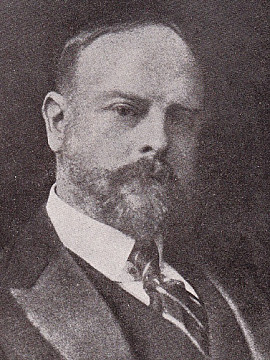Dr. Stanton Coit (1857-1944)
Founder of the West London Ethical Society & Neighborhood Guild
He was born at Columbus, Ohio, and was educated at Amherst College, Massachusetts (where he claimed to have become influenced by the teachings of Ralph Waldo Emerson); Columbia College, New York; and, the University of Berlin. His mother was a close friend of Susan B. Anthony and he was brought up in a home devoted to social equality. He founded the New York University settlements before becoming a minister in the Ethical Church - a movement that focused on providing humanism, or living "rich and moral lives without reference to religious doctrines or supernatural beliefs." He came to London in 1888 and although he never lost his deep, Columbus drawl, he was naturalised as a British subject. He became the leading figure in the country's Ethical movement founding over 40 societies and succeeded Moncure D. Conway as minister of the South Place Chapel. He was a member of the Women's Franchise League (1890); proposed a vote of thanks at the AGM of the Central National Society in 1891; and, by 1899 was involved in the Independent Labour Party.
His position and fortune improved considerably after 1898 when he married the wealthy German widow, Adele (von Gans) Wetzlar. He adopted her three children by her first marriage and they had one further child together. In 1901, he contributed to the 'Grateful Fund' but Elizabeth Wolstenholme Elmy regretted his involvement: "I am a little sorry that Dr. Stanton Coit is a contributor... I do not wish to be unfair, but I cannot trust him. He seems to me to be more anxious to found a new sect, of which he shall be pope, than to do real service to humanity - I should like to find myself mistaken."
In 1903, Coit was a member of the executive committee of the Central Society for Women's Suffrage and with his wife he was a delegate at the 1904 conference in Berlin at which the International Women's Suffrage Society was founded. Afterwards, Elizabeth Wolstenholme Elmy wrote to Harriet McIlquham: "Lucy and Susan Anthony and Anna Shaw have much the same opinion of Dr. Coit as I have - that he is a pretty considerable humbug - working really for his own ends. They admire Mrs Coit very much indeed, and think her incomparably his superior in ability, industry and usefulness. The thing they count most to his credit... is that he has won and returns the love of such a woman - but - he does not half appreciate her." He lived comfortably between his wife's homes, 30 Hyde Park Gate in London and "The Birlings" overlooking Birling Gap on the East Sussex coast.
His position and fortune improved considerably after 1898 when he married the wealthy German widow, Adele (von Gans) Wetzlar. He adopted her three children by her first marriage and they had one further child together. In 1901, he contributed to the 'Grateful Fund' but Elizabeth Wolstenholme Elmy regretted his involvement: "I am a little sorry that Dr. Stanton Coit is a contributor... I do not wish to be unfair, but I cannot trust him. He seems to me to be more anxious to found a new sect, of which he shall be pope, than to do real service to humanity - I should like to find myself mistaken."
In 1903, Coit was a member of the executive committee of the Central Society for Women's Suffrage and with his wife he was a delegate at the 1904 conference in Berlin at which the International Women's Suffrage Society was founded. Afterwards, Elizabeth Wolstenholme Elmy wrote to Harriet McIlquham: "Lucy and Susan Anthony and Anna Shaw have much the same opinion of Dr. Coit as I have - that he is a pretty considerable humbug - working really for his own ends. They admire Mrs Coit very much indeed, and think her incomparably his superior in ability, industry and usefulness. The thing they count most to his credit... is that he has won and returns the love of such a woman - but - he does not half appreciate her." He lived comfortably between his wife's homes, 30 Hyde Park Gate in London and "The Birlings" overlooking Birling Gap on the East Sussex coast.
Parents (2)
Spouse (1)
Share
The Women's Suffrage Movement: A Reference Guide 1866-1928 (2003), by Elizabeth Crawford.




